Although I don’t have the time needed to really get into more details on this topic I discuss it in much greater detail in the Wall Street Investment Bible.
I wanted demonstrate to you that Wall Street research is usually behind the curve, making it more useless than beneficial.
If you work in the industry, then you probably already know this.
As an example, I am going to discuss Fossil (FOSL).
Today, shares of Fossil (FOSL) soared by 32% after beating earnings.

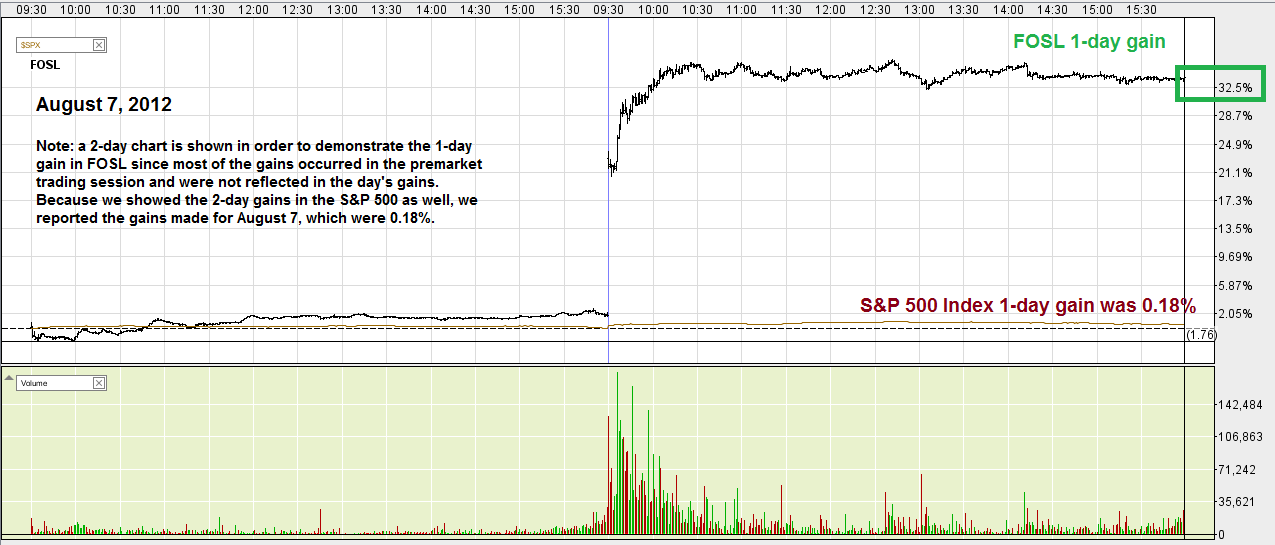
As you may already know, shares were pummeled a few months ago after reaching all-time highs of $140 after missing earnings due to weakening economic conditions in Europe.

Prior to that, FOSL showed absolutely no technical signs of possible collapse.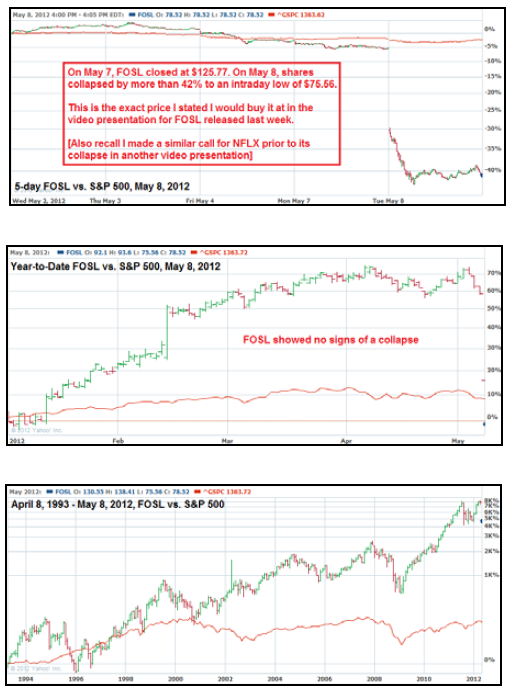
Did the analysts downgrade the stock BEFORE shares collapsed?
Of course not. As is most often the case, analysts remained bullish on FOSL, until it missed earnings.
And once it collapsed from $131 to $75 in a single day, analyst downgrades piled in.
But how does that process help individual investors? It doesn’t.
The fact is that institutions usually get in early to sell before the typical investor has a chance to get out, leaving them holding the bag when it empties.
Analysts aren’t paid to help YOU. They are paid to SELL you. In the end, if you listen to analysts you’re going to get butchered.
You will get the same result if you waste time watching CNBC or reading the Wall Street Journal, Bloomberg, Investor’s Business Daily, and the rest of the financial media.
The media is similar to Wall Street; each is designed to take your money.
It doesn't take a genius to realize that the media's main goal is to mislead its audience because Wall Street buys the advertisements and Wall Street pays the analysts.
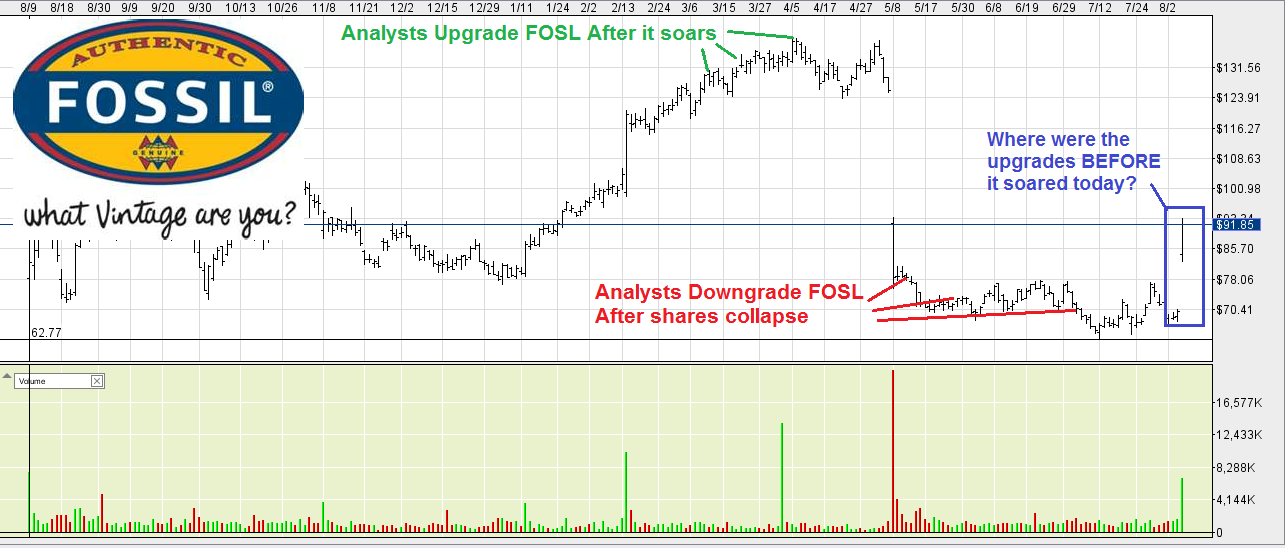
If you haven’t figured this out by now, after all of the articles I’ve written on media deception and con artists, you probably never will.
Now, if you think Wall Street research is useless, you’ll get nothing but material for a standup routine when you see what comes out of discount (online) brokerage firms like Charles Schwab, E-Trade, Fidelity and others.
Just when you thought things got as bad as possible, they get even worse.
There are also media and publishing companies claiming to have credible research departments, like Morningstar, Thompson Reuters, thestreet.com, Zachs, Value Line, and an entire host of others.
However, I actually called the bottom in FOSL well before the collapse.
As many of you already know, in late April of this year, I created a video.png) presentation called “20 Stocks Over $100.”
presentation called “20 Stocks Over $100.”
This presentation was a series of 20 videos of about 10 to 20 minutes each, going over the technical, fundamentals, valuation, risks, challenges, opportunities, forward guidance, entry and exit prices and so forth for each security.
Other recent winners from this list can be found here: [1] [2]
At the time this video series was created, FOSL was trading at around $131.
As you will see in the video below, I basically stated that while it was a great company, it faced some big issues due to the expected drop off in discretionary spending, as well as the problems in Europe.
In the video presentation, I concluded that a good entry price would be in the mid-70s. You'll notice the presentation doesn't sound scripted because it's not.
Scripted presentations may sound nice, but they're usually useless. The FOSL presentation is like all of my video and live presentations; it's real and it's useful.
Hopefully, you will agrees that the presentation was in fact, REAL USEFUL.
A week later, FOSL missed earnings and only then were analysts concerned about the company’s European exposure.
Shares collapsed in one day from about $126 to $75, where they remained in a trading range from the low-60s to the low-80s.
.png)
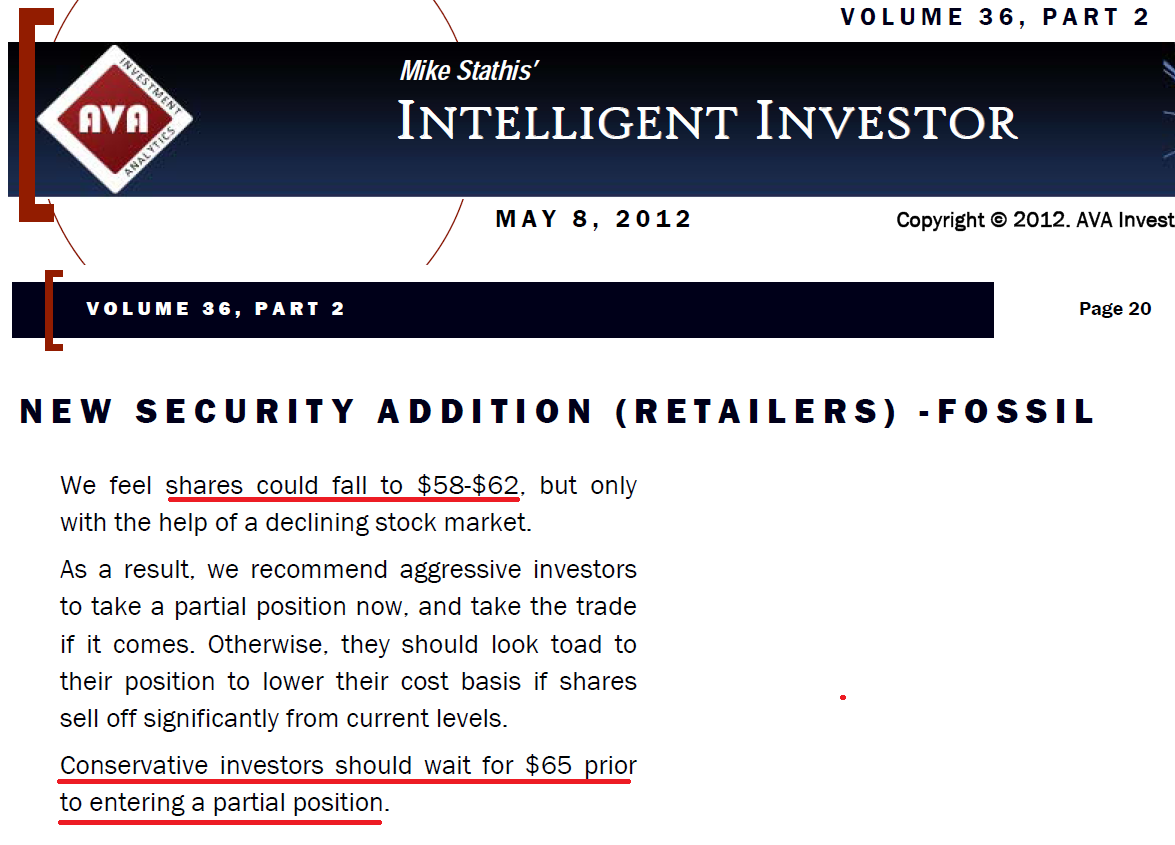
Thus, those who bought FOSL as recommended in the video presentation racked up at least a nice 30% gain.
And subscribers of the Intelligent Investor who followed our recommendations to buy shares at $65 were rewarded with a 40% gain in 3 weeks.
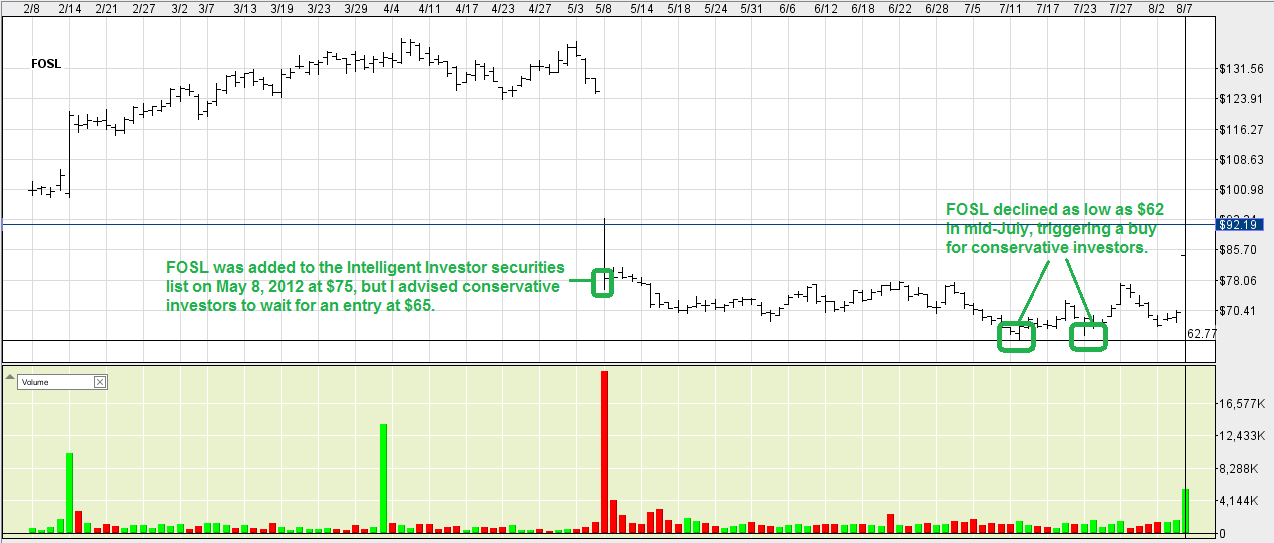
Of course, many analysts downgraded FOSL only after it collapsed, as is usually the case.
Hey, shit happens right?
I’ve found myself downgrading stocks after a material event, but this is a rarity for me.
And it’s even rarer that I downgrade a stock based on an earnings report AFTER it has already collapsed by 40%.
In contrast, this is very typical for Wall Street. If you were not aware of this reality, I suggest you pay close attention to analyst ratings and you will see that this is true.

So how was I able to absolutely nail the collapse down to the exact bottom (within 1% of the bottom) before it soared?
As you can imagine, stocks over $100 have been among the strongest performers which is why the share price is over $100, right?
As a result, I will guarantee you that anyone else who might have created a similar presentation would have taken a bullish stance on each of these stocks, recommending buys.
How do I know this?
Because virtually everyone who provides (or tries to provide) securities analysis is clueless. They lack the ability to analyze companies and the analogous stock. They are followers, so they follow the momentum.
As well, most people will tend to buy the research if it is positive because most people are always looking to buy.
Very few people buy research that warns them against a potential collapse. This is why most people lose money in the stock market. They don’t appreciate the need to understand risk.
I don't do generate research reports based on their ability to lead to sales. I do the research and report my results. People pay me not necessarily to be right every time because that's impossible. I get paid for my insight and judgment because it's highly-valued by guys who know what's going on.
Fortunately, my accuracy rate in all forecasting activities (economic, market, trading guidance, commodities, currencies, precious metals) is around 85% to 90%.
I challenge you to find anyone who is able to come close to that accuracy rate in just one category.
And because I integrate the full spectrum of variables, my research is geared towards making money or avoiding loss.
Analyst research is only focused on short-term catalysts and does not consider other variables such as economic and market risk, technical analysis and so forth. As a result, analyst research doesn't really factor in risk management.
And they often don't even nail the catalysts. FOSL is a perfect example. Both the collapse of FOSL and the huge rally caught analysts by surprise.
Understanding and measuring risk enables one to not only minimize losses, it also helps determine opportunities. This is something very few investors realize.
But I didn’t necessarily take a bullish stance on each security presented in this 3-hour video series, nor did I necessarily hammer them as some extremist contrarian would do.
So what did I do then?
I provided a realistic analysis which was focused on risk and valuation based on my forecasts for global economics, industry dynamics, company fundamentals, market valuation and risk.
As a result, for most of these securities I recommended waiting for a large pull back or collapse prior to entering. Essentially, I called each one as I saw it.
Now I don’t mind letting everyone know one of the 15 securities on the recommended list for the Intelligent Investor because it doesn’t matter.
Should you buy FOSL now?
Should you buy it after waiting (and hoping for) a pullback?
Should you sell it now if you held it before?
Should you buy more?
Should you short it?
Only subscribers to the Intelligent investor are going to know what to do because we train them (via a gradual process) to understand how to customize investment decisions based on their own situation.
We provide the analysis and guidance and let each reader determine how to deal with their positions.
And we offer the single most comprehensive, insightful and accurate investment newsletter in the world, which is why fund managers, financial advisers and analysts subscribe to it.
Unless you understand how to manage the stock, you aren’t likely to make money.
Forget what the salesmen working at brokerage firms and con artists interviewed in the media have been telling you; TIMING DOES MATTER.
The reason why they state otherwise is because they have no clue what they're doing, so they want you to believe no one can time the stock market consistently.
Apparently, they haven't been paying attention to AVA Investment Analytics.
If you aren’t really good at valuation, technical analysis, market forecasting, economic forecasting, asset and risk management, you aren’t going to know what, when or if to buy, sell, accumulate, hold or sell FOSL.
Recent Winners (as of 8/2012): [1] [2] [3] [4] [5] [6] [7] [8] [9] [10] [11] [12]
MORE ON THE INTELLIGENT INVESTOR
ANOTHER Security From Our Recommended List Gets Bought Out
We Predicted The Market Correction AGAIN
Does AVA Investment Analytics Have Insider Information?
We Pin-Pointed the Past Two Market Tops And Bottoms
4-Day Gains of 30% for 2011 and 2010 Performance
Another Huge Winner in a Few Weeks
Newsletter Stock Recommendation Soars More Than 25% in Just 3 Days
Can a Book Serve as a Crystal Ball?
Since The Market Lows, Only One Man Continues To Shine
Mike Stathis' Near-Perfect Market Forecasting Record
Mike's Top 3 Stocks for Long-term Growth
Where Is The Stock Market Headed?
$100,000 Challenge Backing my Claims
Some Notes about the Securities in the Recommended List
Keep in mind that none of the securities on our recommended list is a buy-and-hold.
Each month we provide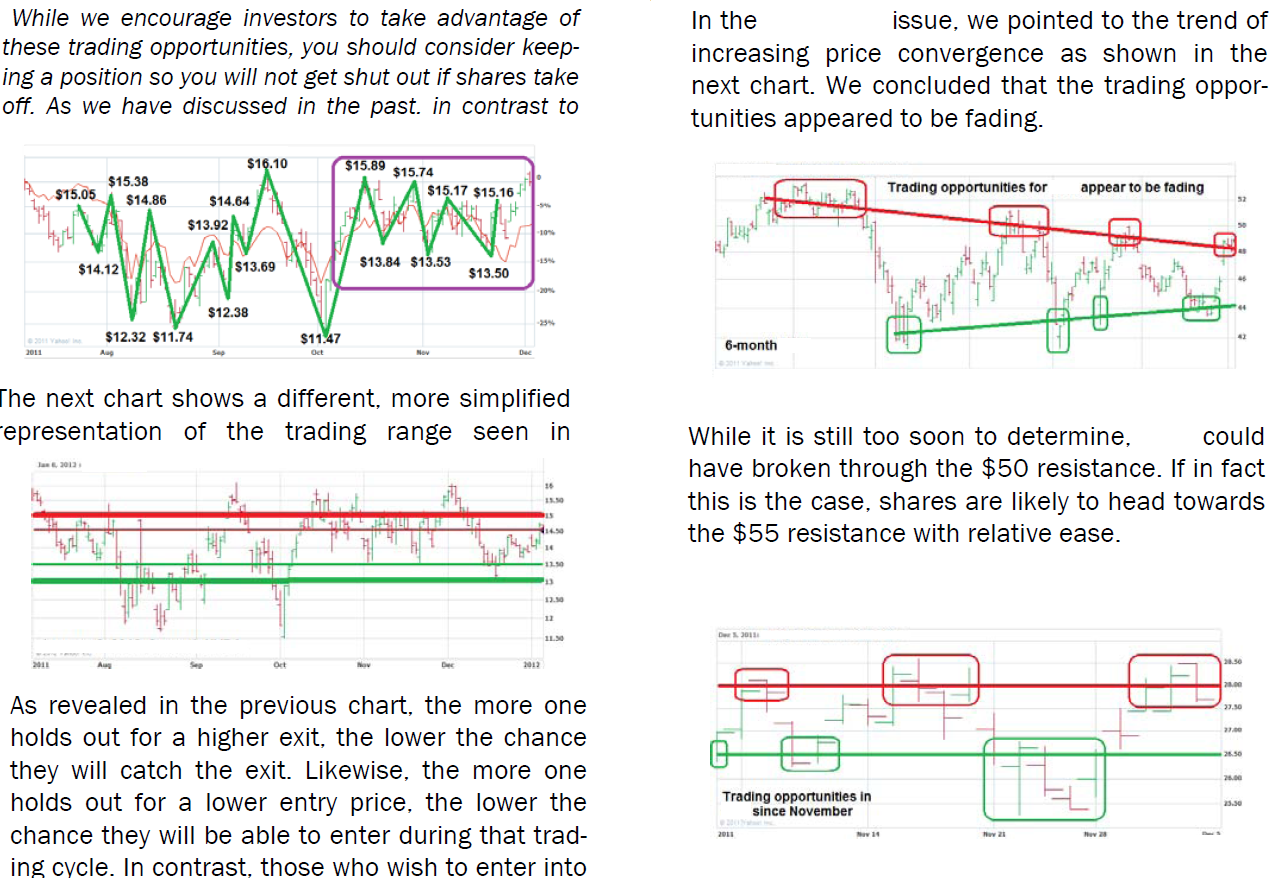 trading guidance for every security.
trading guidance for every security.
In fact, even when securities on the list are trending downward, we provide entry and exit prices enabling investors to capture profitable trades while the stock is declining (due to the see-saw effect that often occurs with pricing).
In addition, we add and remove the securities on this list as needed.
There are a few securities that have been on the list since we began making a recommended list or shortly thereafter.
Other securities have been taken off the list only to be added at a later time when the risk has declined and the opportunity has expanded. 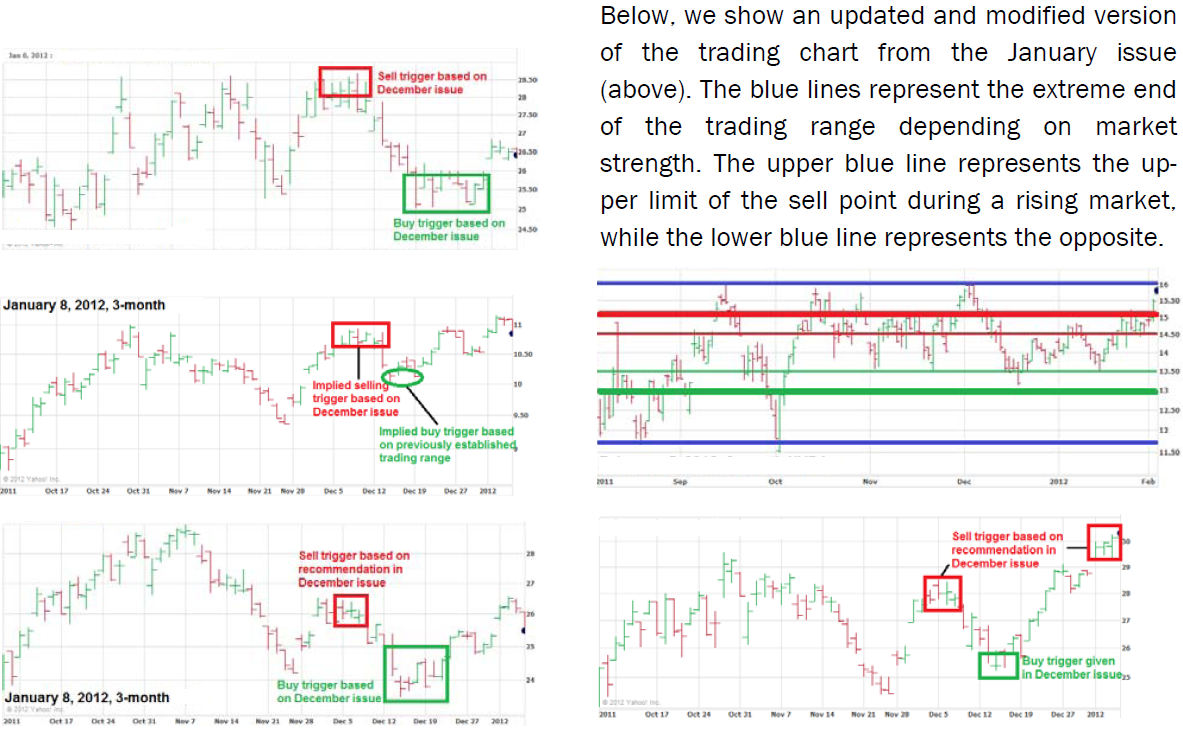
Because it is the trading guidance that is the most critical portion of the securities section, it is extremely difficult and time-consuming for us to publish performance results.
For instance, we do not just issue a buy or sell. We usually present a scenario analysis and recommended actions for conservative versus aggressive investors so each reader can customize their decisions based on their risk tolerance as well as adjusting for changes in the market and economy (via the scenario analysis).

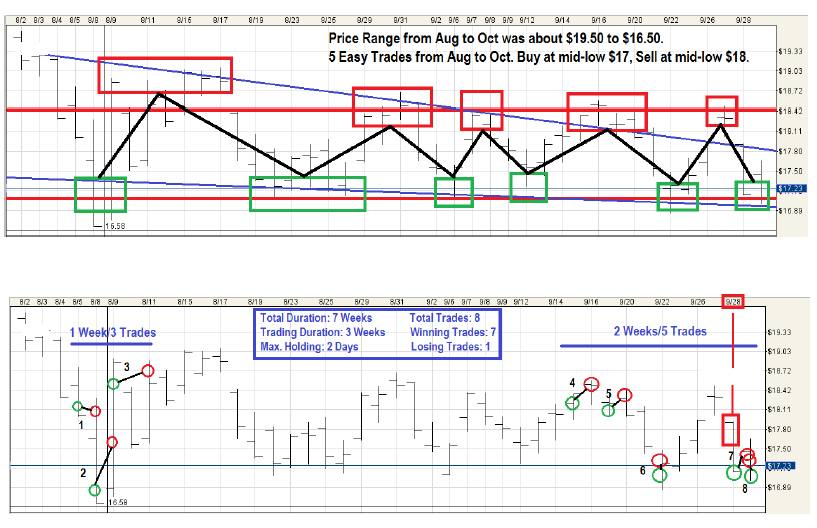
Restrictions Against Reproduction: No part of this publication may be reproduced, stored in a retrieval system, or transmitted in any form or by any means, electronic, mechanical, photocopying, recording, scanning, or otherwise, except as permitted under Section 107 or 108 of the 1976 United States Copyright Act, without the prior written permission of the copyright owner and the Publisher.
These articles and commentaries cannot be reposted or used in any publications for which there is any revenue generated directly or indirectly. These articles cannot be used to enhance the viewer appeal of any website, including any ad revenue on the website, other than those sites for which specific written permission has been granted. Any such violations are unlawful and violators will be prosecuted in accordance with these laws.
Article 19 of the United Nations' Universal Declaration of Human Rights: Everyone has the right to freedom of opinion and expression; this right includes freedom to hold opinions without interference and to seek, receive and impart information and ideas through any media and regardless of frontiers.
This publication (written, audio and video) represents the commentary and/or criticisms from Mike Stathis or other individuals affiliated with Mike Stathis or AVA Investment Analytics (referred to hereafter as the “author”). Therefore, the commentary and/or criticisms only serve as an opinion and therefore should not be taken to be factual representations, regardless of what might be stated in these commentaries/criticisms. There is always a possibility that the author has made one or more unintentional errors, misspoke, misinterpreted information, and/or excluded information which might have altered the commentary and/or criticisms. Hence, you are advised to conduct your own independent investigations so that you can form your own conclusions. We encourage the public to contact us if we have made any errors in statements or assumptions. We also encourage the public to contact us if we have left out relevant information which might alter our conclusions. We cannot promise a response, but we will consider all valid information.